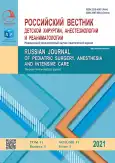Ultrasound technologies in the diagnosis, treatment, and rehabilitation of children with testicular torsion
- Authors: Komarova S.Y.1,2, Tsap N.A.1,2, Karachev I.A.2
-
Affiliations:
- Urals State Medical University
- Children’s City Clinical Hospital No. 9
- Issue: Vol 11, No 3 (2021)
- Pages: 351-358
- Section: Original Study Articles
- URL: https://journals.rcsi.science/2219-4061/article/view/123541
- DOI: https://doi.org/10.17816/psaic976
- ID: 123541
Cite item
Full Text
Abstract
AIM: This study improves the diagnosis of testicular inversion in children to select different treatment strategies by determining the effectiveness of conservative and surgical testicular detorsion criteria.
MATERIALS AND METHODS: The clinical data from 2010 to 2020 included 110 children with testicular torsion. In 64% of cases, the left testicle predominated. Testicular torsion occurred in 50% of children in the 12- to 14-year-old age group. The time from disease onset to seeking medical help ranged from 1.5 hours to 11 days. It was less than 6 hours in 41.8% of children, from 6 to 12 hours in 13.6% of boys, 12 to 24 hours in 11% of patients, and more than 24 hours in 33.6% of boys and adolescents. The protocol for the diagnosis, treatment and rehabilitation of all children included various techniques for ultrasound examination of the scrotal organs.
RESULTS: The analysis showed the absence of reliable criteria for detecting testicle torsion in the early periods (61%–100%): spiral course of the spermatic vessels (63.9%), change in the position of the testicle (19.8%), increase in the volume of the testicle and appendage (98.3%), a change in testicle shape and the inability to withdraw its poles (47.5%), and a hydrocele (67.2%). The index of false-negative results of the ultrasound scan of the scrotal organs reaches 40%. Conservative navigation detorsion was performed in 39 (35.5%) boys and adolescents during the early disease stages. The ultrasound criteria for the effectiveness of conservative detorsion were established. The main criteria normalized blood flow in the testis (100%). Surgical treatment of testicular inversion was performed in 71 (64.5%) boys and adolescents.
CONCLUSIONS: Compliance with the protocol for diagnosing, treating, and rehabilitating children in different age groups with testicular torsion allowed us to determine adequate emergency treatment strategies and follow-up. An ultrasound differential diagnosis is performed with testicular hydatid torsion and inflammatory diseases of the scrotal organs. The informativeness of the ultrasound methods amounted to 60%.
Keywords
Full Text
##article.viewOnOriginalSite##About the authors
Svetlana Yu. Komarova
Urals State Medical University; Children’s City Clinical Hospital No. 9
Author for correspondence.
Email: urokom@yandex.ru
ORCID iD: 0000-0003-2966-2887
SPIN-code: 9411-6025
Cand. Sci. (Med.)
Russian Federation, 3 Repin str., Ekaterinburg, 620028; EkaterinburgNatalya A. Tsap
Urals State Medical University; Children’s City Clinical Hospital No. 9
Email: tsapna-ekat@rambler.ru
ORCID iD: 0000-0001-9050-3629
SPIN-code: 7466-8731
Dr. Sci. (Med.), Professor
Russian Federation, 3 Repin str., Ekaterinburg, 620028; EkaterinburgIl’ya A. Karachev
Children’s City Clinical Hospital No. 9
Email: kara4ev83@yandex.ru
SPIN-code: 1059-4501
ultrasound doctor
Russian Federation, 3 Repin str., Ekaterinburg, 620028References
- Hegele A, Wappelhorst D, Varga Z, et al. Predictors of Spermatic Corsion Torsion — Clinical Presentation and Intraoperative Disclaims. Open Journal of Urology. 2011;1(4):81–85. doi: 10.4236/oju.2011.14017
- Lavallee M, Cash J. Testicular torsion: evaluation and management. Curr Sports Med Rep. 2005;4(2):102–104. doi: 10.1097/01.csmr.0000306081.13064.a2
- Yusufov AA, Pykov MI, Rumyantseva GN. Metodika ul’trazvukovogo issledovaniya organov moshonki u detei. Ehffektivnaya farmakoterapiya. 2011;(30):36–43. (In Russ.)
- Olkhova EB, Yutkina MS. Ultrasound diagnostic of the neonatal testicular torsion. Radiology and practice. 2015;(2):14–22. (In Russ.)
- Kadyrov ZA, Teodorovich OV, Zhukov OB. Atlas ul’trazvukovoi diagnostiki organov moshonki. Moscow: BINOM, 2018. 128 p. (In Russ.)
- Boettcher M, Krebs T. Clinical and sonographic features predict testicular torsion in children: a prospective study. BJU Int. 2013;112(8):1201–1206. doi: 10.1111/bju.12229
- Xiang H, Han J, Ridley WE, Ridley LJ. Snail shell sign: testicular ovarian torsion. J Med Imaging Radia Oncol. 2018;62(S1):106. doi: 10.1111/1754-9485.50_12784
- Sharp VJ, Kieran K. Testicular torsion: diagnosis, evaluation and management. Am Fam Physician. 2013;88:12.
- Tekgül S, Dogan HS, Erdem E, Hoebeke P. Guidelines on Paediatric Urology. ESPU, 2015. 14–15 p.
- Kovarskiy SL, Gurevich AI, Zakharov AI, et al. Tactics of treatment of patients with testicular torsion on the example of three patients. Pediatric and adolescent reproductive health. 2021;17(1):63–71. (In Russ.) doi: 10.33029/1816-2134-2021-17-1-63-71
Supplementary files










